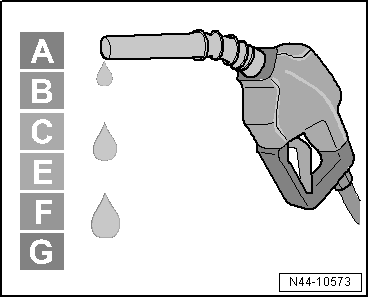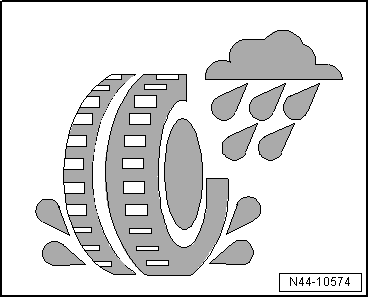Volkswagen Golf Service & Repair Manual: EU tyre label, categories
| Rolling resistance
→ Anchor |
|
|
|
| Defined as, energy consumed by the tyre in respect of the
distance travelled. |
| Equates to the energy lost per defined unit of distance
travelled. |
| The energy form can be described as the quotient of Newton
meter (Nm) and distance travelled in meter (m). This then
provides a rolling resistance as a form of force in Newtons (N). |
| The rolling resistance of a tyre is then described by the
coefficient of rolling resistance (also known as rolling
resistance coefficient) cR: |
| cR - coefficient of rolling
resistance |
| FR - force of rolling resistance |
| Z - weight of vehicle (sum of all wheel loads) |
| Reduction of rolling resistance |
| Reduction of fuel and CO2 |
|
|

|
| Structured in fuel efficiency categories from A to G |
 Note Note
| The fuel efficiency category is listed in EU regulation (EC)
No. 1222/2009, the tyre is then allocated to the respective
category. |
| The rolling resistance is established by the tyre
manufacture via prescribed tests. |
| The lower the rolling resistance, the lower the fuel
consumption. |
| A - |
Lowest rolling resistance = lowest fuel consumption |
|
|

|
| The wet grip index G must be established for the wet grip.
The wet grip index G is established using a deceleration test
(distance required to decelerate from 80 km/h to 20 km/h) using
a standardised vehicle on a wet slippery surface. The test uses
a predefined standard reference test tyre (SRTT), with which the
wet grip index G can be calculated. The calculation uses the
mean fully developed deceleration (mfdd) produced. |
| The mean fully developed deceleration (mfdd) is calculated
as follows: |
| S - the measured braking distance in metres between 80 km/h
and 20 km/h |
| The wet grip index G is calculated as follows: |
| |
G =
| mfdd of tyre
to be checked |
| mfdd of standard reference test tyre |
|
| mffd - mean fully developed deceleration |
| Greatly reduced bake distance |
|
|

|
| Structured in wet grip categories from A to G |
| Categories D and G are not used |
 Note Note
| The wet grip category is listed in EU regulation (EC) No.
1222/2009, the tyre is then allocated to the respective
category. |
| The lower the wet grip index, the shorter the braking
distance. |
| A - |
Lowest wet grip index = shortest braking distance |
| B - |
3 to 6 m longer braking distance in comparison with category
A |
| C - |
3 to 6 m longer braking distance in comparison with category
B |
| E - |
3 to 6 m longer braking distance in comparison with category
C |
| F - |
3 to 6 m longer braking distance in comparison with category
E |
| 1 - |
The braking distance between categories A and F can be more
than 18 m when undertaking an emergency stop at 80 km/h. |
|
|

|
| Reduction of pass-by noise |
| Measured on outside of vehicle only |
| Divided into three categories |
|
|

|
| Three black arcs indicate the worst performance. The tyres
produce a rolling noise that lies below the current limit
according to EU regulation 2001/43/EG. The limit lies above the
limit that has been set for from 2016 according to regulation
(EG) No. 661/2009. |
| Two black arcs: The tyre noise limit lies below the limit
that has been set for from 2016 according to regulation (EG) No.
661/2009. |
| One black arc: The tyre noise limit lies below the limit
that has been set for from 2016 according to regulation (EG) No.
661/2009, by at least three decibels. |
 Note Note
| Reducing the noise level from two arcs to one arc equates to
3 dB, which halves the noise level. |
| Note, the external rolling noise of the tyre does not always
correspond with the noise in the vehicle interior. |
|
|

|
Reducing fuel consumption
Increasing road safety
Reducing traffic noise
The EU tyre label provide ...
© 2016-2024 Copyright www.vwgolf.org

 Note
Note Note
Note Note
Note EU tyre label, objectives
EU tyre label, objectives






